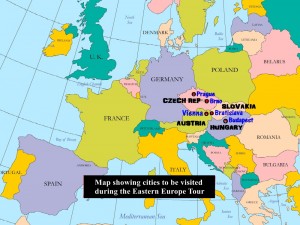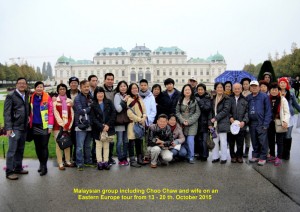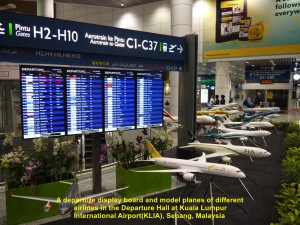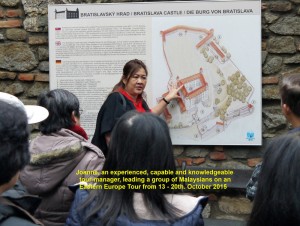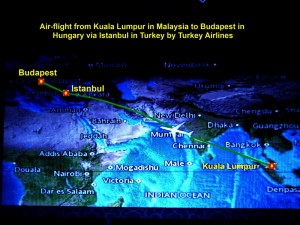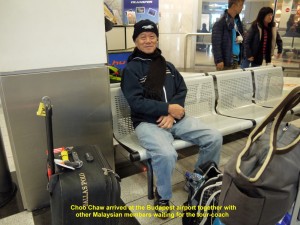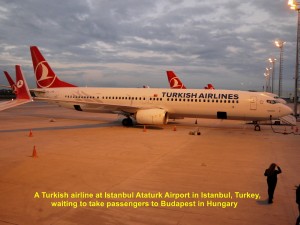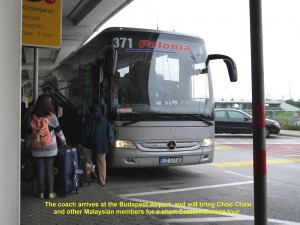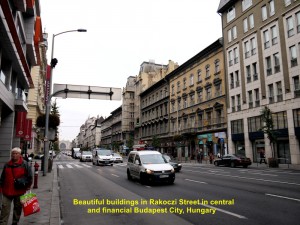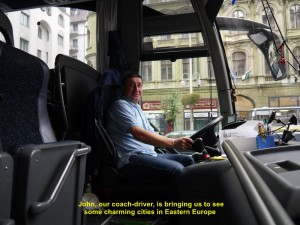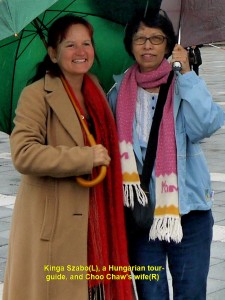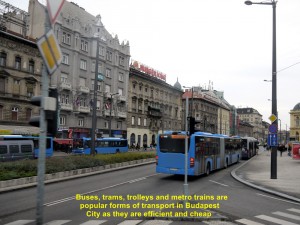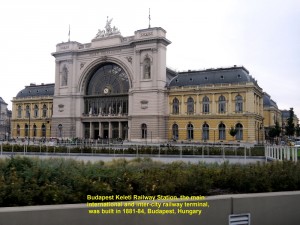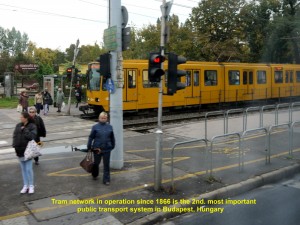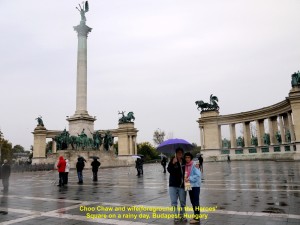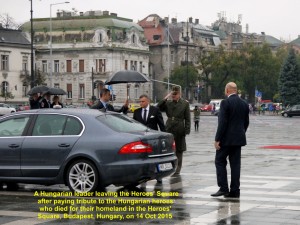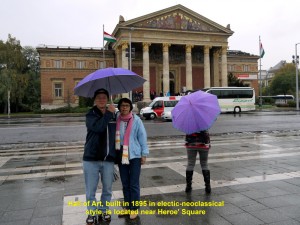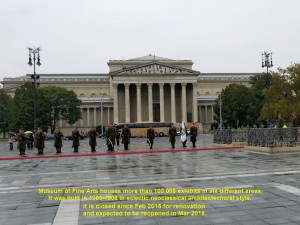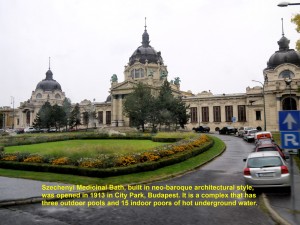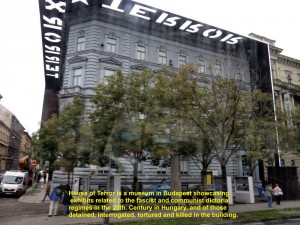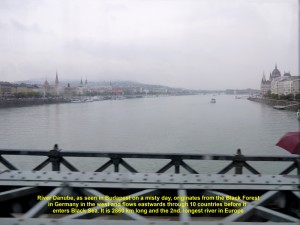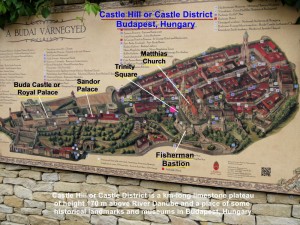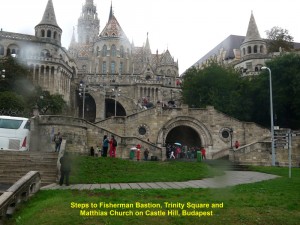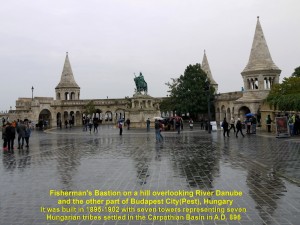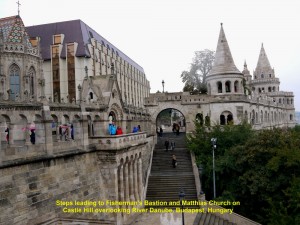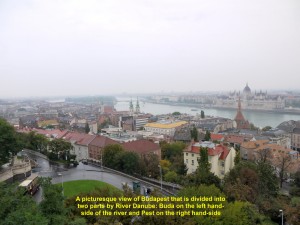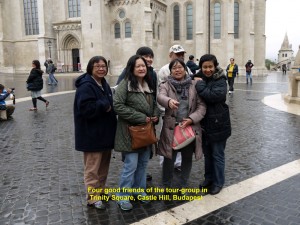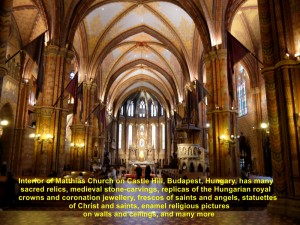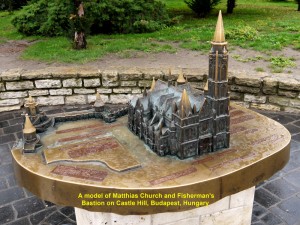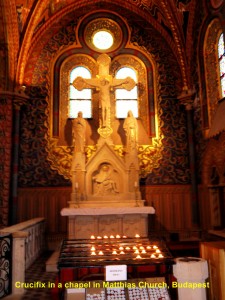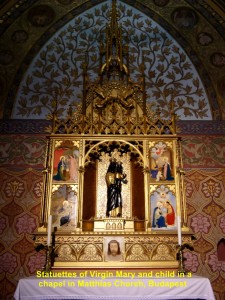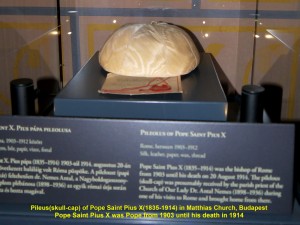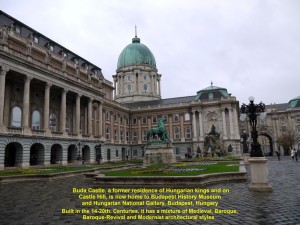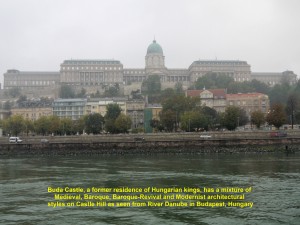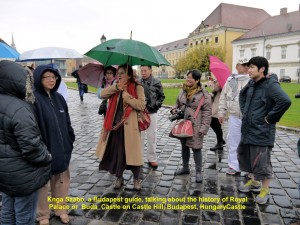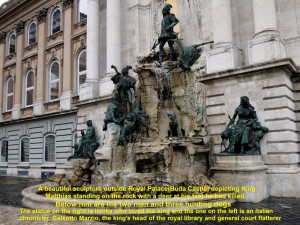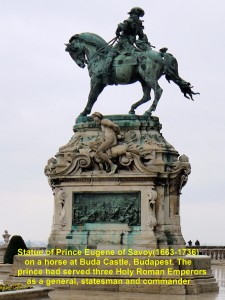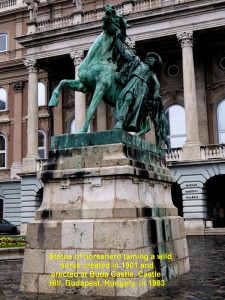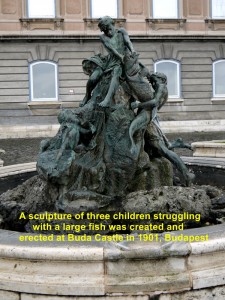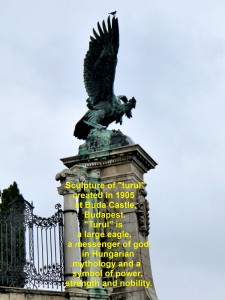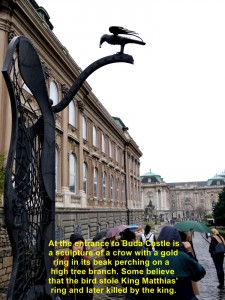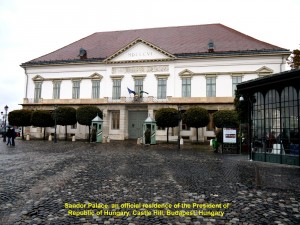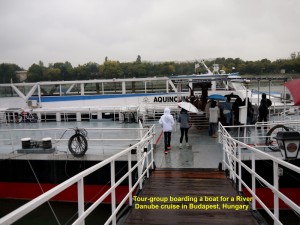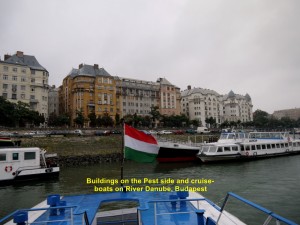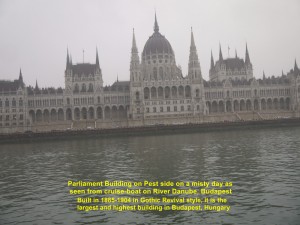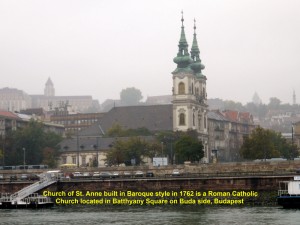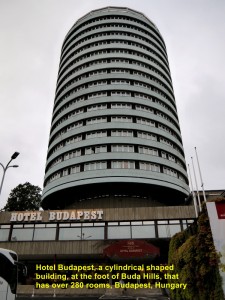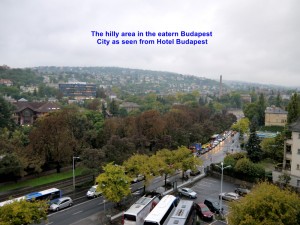Eastern Europe Tour Part I(Budapest)
Eastern Europe Tour Part I(Budapest)
Journey to Budapest, Hungary
Tuesday, 13 October 2015
KLIA – Istanbul Ataturk Airport – Budapest Airport
On 13 October 2015, a group of 26 Malaysians, including my wife and myself, reported to a tour manager, Joanne Wong, at the Kuala Lumpur International Airport(KLIA), Sepang, Malaysia. Then together we boarded a Turkish airline of model Airbus 330-300 at 11.25 p.m.(Malaysian time) and left the airport for Istanbul Ataturk Airport.
After flying a distance of about 8350 km in ten and a half hours, it landed at the Istanbul airport where we waited for a while for another Turkish airplane to take us to Budapest in Hungary. At 7.25 in the morning our new plane took off and travelled for the remaining distance of about 1000 km in 1 hour and 30 mins before it landed at Budapest Ferenc Liszi International Airport in Hungary.
Wednesday, 14 October 2015
Budapest City
On arrival at the Budapest airport, we waited for a short while for our coach. Soon it came and we all boarded it. It was driven by John, a Polish. John drove us to the Budapest City to meet a Hungarian tour-guide. While the coach was moving in the city we were charmed by the buildings which were built in many different architectural styles, including Neo-classical, Baroque, Renaissance and Gothic. In fact, they look like the buildings in Old Paris in France.
Budapest is the capital of Hungary and formed from the unification of three cities, viz. Buda, Pest and Old Buda. Its metropolitan area has a population 0f 3.3 millions and 52% of them is Roman Catholic. The city has many historical landmarks that make it one of the most popular tourists’ destinations in the world.
When the tour-guide appeared, she greeted us and introduced herself. She is a Hungarian and her name is Kinga Szabo. Then we all went together to the Heroes’ Square located at the end of Andrassay Avenue, our first place of visit.
On the way, we saw buses and trams which are popular means of public transport in the city. Besides, we saw a railway station built in eclectic architectural style in 1881-1884. Its facade is adorned with two statues of James Watt(inventor of steam engine) and George Stephenson(inventor of steam locomotive). It is called Budapest Keletic Station and a main terminal for international and inter-city railway networks.
Heroes’ Square
Heroes’ Square is a Hungary’s important monument created in memory of those Hungarians, including kings and leaders of tribes, who had fought for their country.
In the centre of the monument is a tall column with a statue of Archangel Gabriel atop and seven statues of Hungarian leaders of seven tribes who brought their people to Carpathian Basin in 896 at its base. Behind the column are two colonnades. There are seven statues of Hungarian kings on the left one and a statue of a Hungarian king, Matthias, and six statues of important figures who had fought in Hungarian wars on the right.
In front of the tall column is a tomb of an unknown soldier.
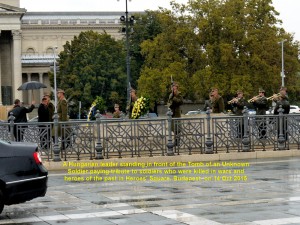
An important person paying tribute to soldiers killed in past wars and heroes of Hungary in Heroes’ Square, Budapest
Tribute Ceremony
It was drizzling when we arrived in the square. While we were looking at the statues of heroes from a distance, an important person came and walked up to the Tomb of Unknown Soldier in the middle of the square. He was accompanied by military officers. He stood in front of the Tomb and paid tribute to the soldiers killed in past wars and heroes of the country while three soldiers were playing a music. Then he was driven away. (I am wondering who that person was.)
Hall of Art
The Heroes’s Square is between two important buildings. Hall of Art on its right is a museum of contemporary art built in electic neoclassical architectural style in 1895.
Museum of Fine Arts
Museum of Fine Arts is on the left of the Heroes’ Square. Built in eclectic neoclassical architectural style in 1900-1906, it showcases six departments of art collections of more than 100 000 exhibits, viz. Egyptian, antique, old sculpture gallery, old painter gallery, modern arts and graphic arts. This museum is closed since February 2015 for renovation and expected to be reopened in March 2018.
Szechenyi Medicinal Bath
Behind the Heroes’ Square is a building complex which has three outdoor pools and 15 indoor pools filled with underground hot water containing minerals that are good, especially, for joint ailments. It is known as Szechenyi Medicinal Bath. Constructed in 1909 in neo-Baroque architectural style, it is the largest medicinal bath in Europe.
House of Terror
Having seen the Heroes’ Square, we left the place and moved on to Castle Hill in the eastern part of the city. While passing through the city, I saw a building with two words of “TERROR” on its eaves. Known as House of Terror and opened in 2002, it is a museum on Andrassy Avenue. It houses exhibits related to the fascist and communist dictatorial regimes in the 20th. Century in Hungary, including those who were detained, interrogated, tortured or killed in the building. It was a venue for Nazi headquarters in WWII.
River Danube
Then we crossed a long bridge spanning a well-known river in Europe. It is called River Danube and its source is in the Black Forest in Germany in the west. It flows eastwards for a distance of 2860 km through ten countries before entering the Black Sea. It is the second longest river in Europe, after the Volga River.
Shoes on the Danube Bank
As we were travelling along the Danube River to Castle Hill, we saw 60 pairs of shoes on the riverbank. Our tour-guide told us that the shoes were made of iron created by a sculptor, Gyula Paner, and fixed there, permanently, in 2005 in memory of the Jews who were killed by fascist Arrow Cross militiamen in Budapest in 1944-45 during WWII(1939-45). The victims were ordered to take off their shoes and stand on the edge of the bank. When they were shot, their bodies fell into the river and floated away.
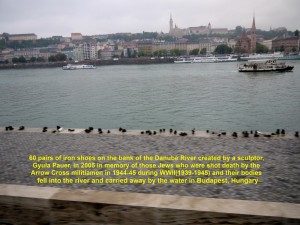
“Shoes on the Danube Bank” in memory of the Jews killed by fascist Arrow Cross militiamen in 1944-45
Castle Hill or Castle District
Several minutes later, we reached Castle Hill and our coach stopped at a spot where we walked up a few flights of steps to the top.
Castle Hill, also known as Castle District, is a kilometre-long limestone plateau that is 170 m above River Danube. It is a popular place among tourists as it has some historical buildings and museums.
On the hill we visited the following important places:
Fisherman’s Bastion
It looks like a broad wall or fortress built on the edge of the Castle Hill with seven towers each having a cone-shaped top. The seven towers represent the seven Hungarian leaders of seven tribes that settled in Carpathian Basin in A.D. 896. The Bastion takes its name from the guild of fishermen responsible for defending the city walls in the Middle Ages. It was built in 1895-1902 in neo-Gothic and neo-Romanesque architectural style. Visitors can go up the hill to the Bastion by using a path and steps.
Standing on the Fisherman’s Bastion, we saw a breathtaking, panoramic view of River Danube and almost the whole city of Budapest, including the Parliament Building and a few bridges spanning the river. One of the bridges is Szechenyi Chain Bridge which is the oldest in the city .Opened in 1849, it is 375 m long.
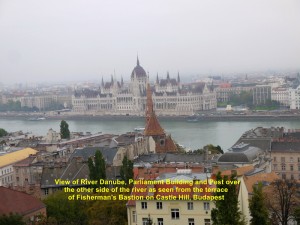
A panoramic view of River Danube, Parliament Building and the rest of Budapest City as seen from Fisherman Bastion, Castle Hill
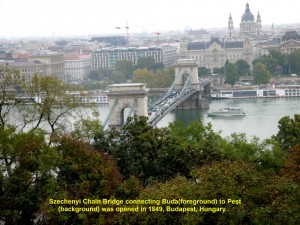
Szechenyi Chain Bridge, opened in 1849 and the oldest bridge in Budapest City, as seen from Castle Hill
In the olden days, Budapest consisted of three cities: the two upper parts east of River Danube that were known as Buda and Old Buda, and the lower part west of River Danube that was Pest. It was in 1873 when they were united to form one city called Budapest that became the capital of Hungary.
Trinity Square Column
Trinity Square is an open space between Fisherman’s Bastion and a Roman Catholic church, Matthias Church. Located in its centre is a tall column known as Holy Trinity Column as it has a sculpture of Trinity on its top.
It was built in 1710-1713 and erected there in memory of those who were killed in plague epidemics in 1691 and 1709 and to ward off the disease.
Statue of King Stephen I(975-1038)
Erected in 1906 in Trinity Square and near Fisherman’s Bastion is the statue of Saint Stephen I(975-1038). He was the first king of Hungary from 1000 till 1038.
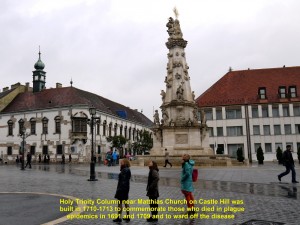
Holy Trinity Square Column built in 1710-1713 in memory of those who died in plague epidemics in 1691 and 1709 in Trinity Square, Castle Square, Budapest
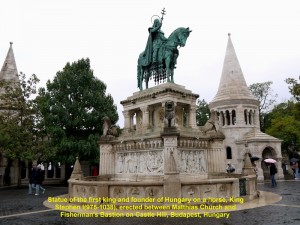
Statue of King Stephen I(975-1038), the first king of Hungary, in the Trinity Square, Castle Hill, Budapest
Matthias Church
In the square is Matthias Church, a Roman Catholic church, that was built in Gothic architectural style in the second half of the 14th. Century. It was, originally, known as “The Church of Our Lady”. In the 19th. Century it was renamed after King Matthias.
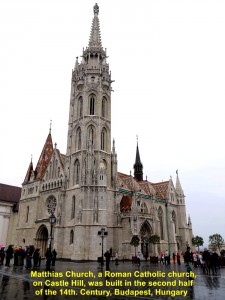
Matthias Church, a Roman Catholic Church, was built in the late 14th. Century, Castle Hill, Budapest
Matthias Church, a church of religious relics
Matthias Church houses some religious relics, medieval stone carvings, replicas of royal crowns, enamel pictures of Lord Jesus Christ and saints, statuettes of Christ, Virgin Mary and saints to name a few.
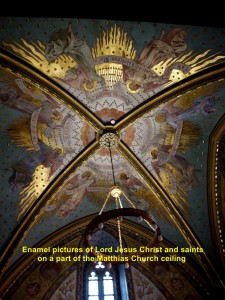
Enamel pictures of Lord Jesus Christ and saints on a part of the ceiling of Matthias Church, Castle Hill, Budapest
Besides, it had carried out some important royal ceremonies, including coronations of two kings, wedding of a king and funerals King Bela III(1748-1792) and his first wife. The king and his first wife were buried in one of its chapels.
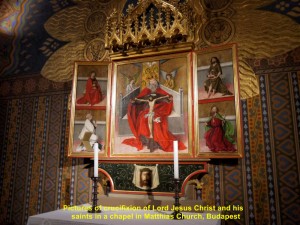
Pictures of the crucifixion of Lord Jesus Christ and saints in a chapel in Matthias Church, Castle Hill, Budapest
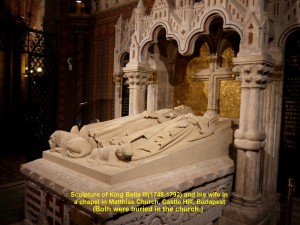
Sculpture of King Bella III(1748-1792) and his first wife in a chapel in Matthias Church and both were buried in the church
Buda Castle or Royal Palace
Built in the 14-20th. Centuries, Buda Castle or Royal Palace was a residence for Hungarian kings. The majestic-looking building is a mixture of some architectural styles, including Baroque, Baroque Revival and Modernist. It now houses Budapest History Museum, National Szechenyi Library and Hungarian National Gallery.
Sculptures around Buda Castle
There are several bronze sculptures around Buda Castle, such as the following:
Sculpture of Matthias Fountain
Standing on top of the rocks is King Matthias with a cross-bow and dead deer at his feet. Below him are his two men and three dogs. This sculpture was created in 1899.
On the right-hand side of the sculpture is a statue of Szep Ilonka who had fallen in love with the king but died of a broken heart when she knew of his true identity. On the left-hand side is Galeotto Marzio, an Italian chronicler who lived and worked in Matthias court.
Sculpture of Taming a Wild Horse
Sculpture of a man taming a wild horse on a high pedestal was created in 1901.
Statue of Prince Eugene of Savoy(1663-1736)
The statue of Prince Eugene of Savoy(1663-1736) on a high pedestal was created in 1900. Prince Eugene was a general of the Imperial Army, statesman and successful commander. He had served three Holy Roman emperors.
Sculpture of Three Children and a Large Fish Fountain
This sculpture done in 1912 depicts three children struggling with a large fish they have caught with a net.
Sculpture of Turul
The sculpture was created in 1905. Turul is a Hungarian mythological eagle. The Hungarians believe that it is a messenger of God that has power, strength and nobility.
Sculpture of Crow with a Gold Ring
At the entrance of Buda Castle there is a sculpture of a crow with a gold ring in its beak perching on a tall tree branch. Some Hungarians believe that the bird stole King Matthias’ gold ring and later the king caught and killed it.
Sandor Palace
This neo-classical building located near Buda Castle is the official residence of the President of the Republic of Hungary. The current president is 56 years old named, Janos Ader. He was elected as the president in 2012 in a parliamentary vote.
While I was there I saw two young sentries guarding the entrance of the President’s residence. I asked one of them for permission to take a photo with him. But he just stood there motionless like a statue. Since my Hungarian tour-guide, Kinga Szabo, said it was fine to take a photo with him, I stood near him and she snapped a photo of us using my camera. Then I thanked her and the sentry. I was not surprised that the latter did not respond.
Sculpture of Grof Bethlen Istvan(1874-1946)
Grof Bethlen Istvan, an aristocrat and statesman, became the Prime Minister of Hungary from 1921 till 1931. Its bronze statue can be seen near Sandor Palace.
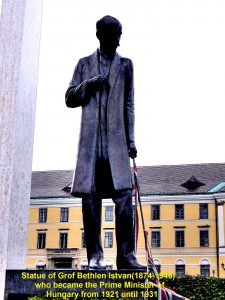
Statue of Grof Bethlen Istvan, the Prime Minister of Hungary from 1921 till 1931, near Sandor Palace, Castle Hill, Budapest
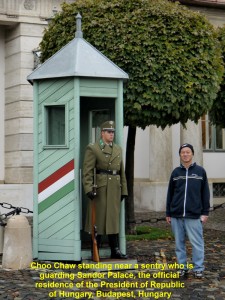
Choo Chaw taking photo with a sentry outside the entrance of President’s residence, Sandor Palace, Castle Hill, Budapest
River Danube Boat-Cruise
Later, we left Castle Hill and went downtown Budapest to have lunch at 1 p.m.. After lunch we went for a boat-cruise on River Danube.
As we were cruising along the river, we saw picturesque views of the cities. Although it was misty and drizzling, lightly, we could still see from our boat Buda Castle on Castle Hill, Church of St. Anne in Batthyany Square, Parliament Building and other quaint buildings along both sides of the river. Besides, we went under two bridges: Margaret Bridge and Szechenyi Chain Bridge, both connecting Buda in the east with Pest in the west.
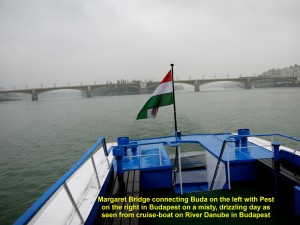
Margaret Bridge as seen on a misty, drizzling day connects Buda on the right with Pest on the left in Budapest
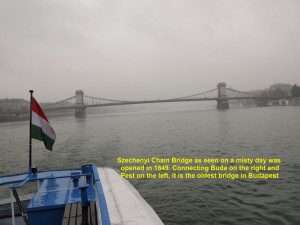
Szechenyi Chain Bridge as seen on a misty, drizzling day connects Buda on the right with Pest on the left and is the oldest bridge in Budapest
Hotel Budapest
After the River Danube boat-cruise, we went for dinner, checked in and stayed for a night at Hotel Budapest which is on the Buda side of Budapest City.
Eastern Europe Travel(13-20 October 2015)

